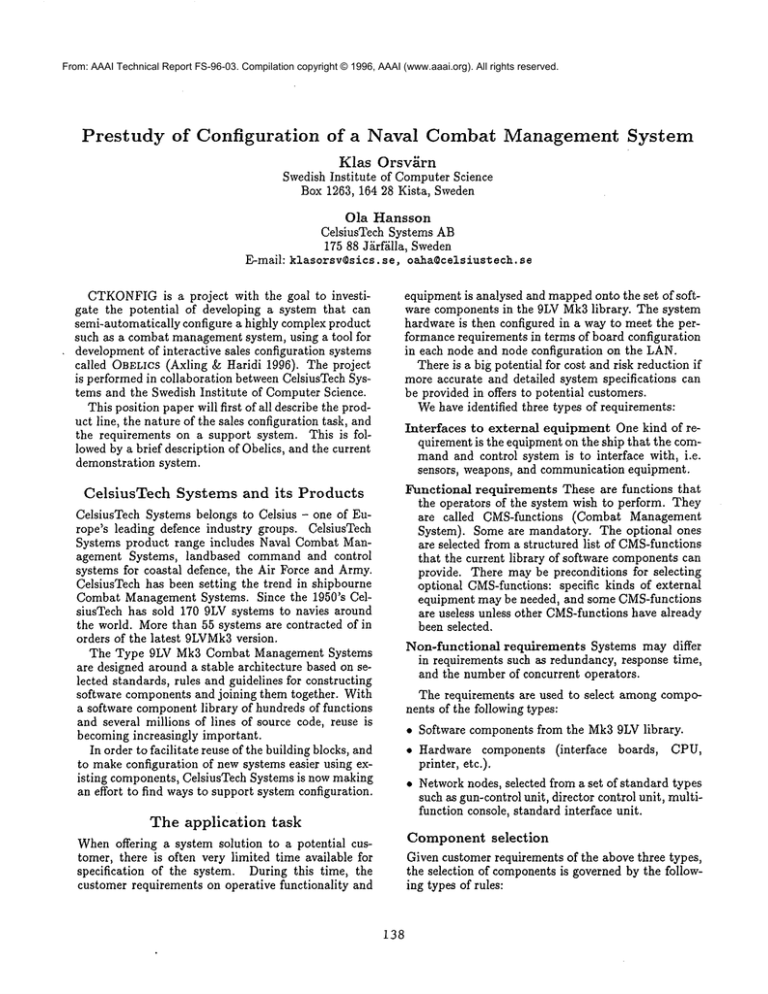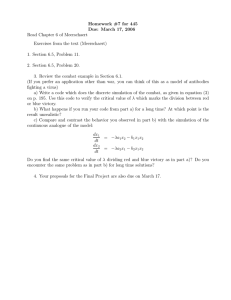
From: AAAI Technical Report FS-96-03. Compilation copyright © 1996, AAAI (www.aaai.org). All rights reserved.
Prestudy
of Configuration
of a Naval Combat Management System
Klas Orsv/irn
Swedish Institute of Computer Science
Box 1263, 164 28 Kista, Sweden
Ola Hansson
CelsiusTech Systems AB
175 88 J~rfdlla, Sweden
F_~mail: klasorsv~sics,
se, oaha¢celsiustech,
se
CTKONFIG
is a project with the goal to investigate the potential of developing a system that can
semi-automatically configure a highly complex product
such as a combat managementsystem, using a tool for
development of interactive sales configuration systems
called OBELICS(Axling & Haridi 1996). The project
is performed in collaboration between CelsiusTech Systems and the Swedish Institute of Computer Science.
This position paper will first of all describe the product line, the nature of the sales configuration task, and
the requirements on a support system. This is followed by a brief description of Obelics, and the current
demonstration system.
CelsiusTech
Systems
and
its
equipment is analysed and mappedonto the set of software components in the 9LV Mk3library. The system
hardware is then configured in a way to meet the performance requirements in terms of board configuration
in each node and node configuration on the LAN.
There is a big potential for cost and risk reduction if
more accurate and detailed system specifications can
be provided in offers to potential customers.
Wehave identified three types of requirements:
Interfaces
to external equipment One kind of requirement is the equipment on the ship that the commandand control system is to interface with, i.e.
sensors, weapons, and communication equipment.
~kmctional requirements These are functions that
the operators of the system wish to perform. They
are called CMS-functions (Combat Management
System). Some are mandatory. The optional ones
are selected from a structured list of CMS-functions
that the current library of software componentscan
provide. There may be preconditions for selecting
optional CMS-functions: specific kinds of external
equipment may be needed, and some CMS-functions
are useless unless other CMS-functions have already
been selected.
Non-functional
requirements Systems may differ
in requirements such as redundancy, response time,
and the number of concurrent operators.
Products
CelsiusTech Systems belongs to Celsius - one of Europe’s leading defence industry groups. CelsiusTech
Systems product range includes Naval Combat Management Systems, landbased command and control
systems for coastal defence, the Air Force and Army.
CelsiusTech has been setting the trend in shipbourne
Combat Management Systems. Since the 1950’s CelsiusTech has sold 170 9LV systems to navies around
the world. More than 55 systems are contracted of in
orders of the latest 9LVMk3
version.
The Type 9LV Mk3 Combat Management Systems
are designed around a stable architecture based on selected standards, rules and guidelines for constructing
software components and joining them together. With
a software componentlibrary of hundreds of functions
and several millions of lines of source code, reuse is
becoming increasingly important.
In order to facilitate reuse of the building blocks, and
to make configuration of new systems easier using existing components, CelsiusTech Systems is now making
an effort to find ways to support system configuration.
The application
The requirements are used to select
nents of the following types:
among compo-
¯ Software components from the Mk39LV library.
¯ Hardware components (interface
boards, CPU,
printer, etc.).
¯ Networknodes, selected from a set of standard types
such as gun-control unit, director control unit, multifunction console, standard interface unit.
task
Component selection
Given customer requirements of the above three types,
the selection of componentsis governed by the following types of rules:
Whenoffering a system solution to a potential customer, there is often very limited time available for
specification of the system. During this time, the
customer requirements on operative functionality and
138
Interlace adaptlon For each interface to external
equipment, and for peripheral equipment such as
printer, specific software componentsare needed for
adapting the signals to a general interface. Likewise,
specific hardware is needed for each interface.
Core system software A large part of the software
system is the same in all systems, e.g. the operating
system, application support functions, data distribution mechanisms, and mandatory CMS-functions.
Optional software For each optional CMS-function,
a specific set of software components is needed for
providing it. The same software component may be
utilized for different CMS-functions.
Network nodes A set of network nodes, from a set
of predefined types, needs to be defined. Somenode
types are specialized for specific kinds of external
equipment, e.g. gun and director, and can thus be
determined directly from the requirements. Other
node types can host a group of external equipment
of any type. Instances of such node types have
to be selected in a way that allows an allocation
of external equipment and software that meets the
non-functional requirements on performance and redundancy. For example, different equipment that is
in some sense equivalent, such as different radars,
should not be allocated to the same node, and software components that have much communication
should be in the same node. Moreover, each node
can have one or more CPU’s, and the estimated CPU
load should not be too high.
A component can be defined to have properties and
relations of the following kinds:
¯ Preconditions, are logical expressions which must be
satisfied before an instance can be selected.
¯ Dependencies to other components.
¯ Attributes, which may have different values according to either methods in terms of other component
attributes, or user selections.
* Sub-classes, i.e. other componentsare sub-classes of
this component.
¯ Sub-components, i.e. other components are subcomponents of this component. The sub-component
relation may be mandatory or optional, and the cardinality may vary.
The knowledge can be entered by editing the component hierarchy graphically. A configuration engine will
generate the problem solving behaviour, by inspecting
the component models. The end-user interface is also
generated on the fly. Configuration begins by trying
to instantiate the top-level component in the hierarchy of sub-classes and sub-components, which leads to
instantiation of its sub-components, etc., while taking
component dependencies into account. OBELIGS is interactive in the sense that it will ask the user whenever
there is a choice to resolve, which cannot be determined
from the component models. Moreover, the user can
edit the configuration, while OBELICS
keeps track of
the dependencies. For a more elaborate description of
OBELICS, see (Axling & Haridi 1996).
The demonstration
Tool requirements
In addition to the task analysis described above, a few
more tool requirements of this application are relevant.
With a product line of this kind, the process of generating a configuration and quotation involves very many
decisions, even with a support system. This means
that the support system must not require the user to
restart configuration wheneversignificant changes need
to be made, either in the current customer requirements, or if new components need to be added in the
product line.
If something is changed in the requirements, e.g.
deleted, it is essential to find out what other decisions
were made by dependency from that, so that they can
be retracted where appropriate.
system
On the basis of the task analysis described above, a
first demonstration system has been developed using
OBELICS.It meets the requirements given above fairly
well, and covers all parts of the configuration task, except allocation of componentsto nodes in the computer
network. The latter is a difficult allocation problem
that Obelics cannot support today. It is possible to
program a solution in Prolog, but we have decided to
postpone this. Nevertheless, it is an important part
of the configuration task, and will occur in other complex configuration domainsas well. In this application,
many considerations need to be taken into account in
the allocation, e.g. reuse, which mayalso be conflicting. This implies that the end user may want to edit
the allocation, and this editing should be taken into
account if the allocation is recomputed.
Obelics
OBELICSwas developed at SICS during 1992"and 1993,
based on the experiences of a fielded system for sales
configuration of low-voltage switch-gear at AIEL, a
subsidiary of ABB. The objective of OBELICSis to
enable very quick development of sales configuration
systems, which could be maintained by domain experts. Applications are developed by representing
product knowledge in a component oriented modelling
language.
Acknowledgements Robert Johansson,
CelsiusTech Systems, and Olle Olsson, SICS, have contributed
to the prestudy reported here.
References
Axling, T., and Haridi, S. 1996. A tool for developing interactive configuration applications. Journal of
Logic Programming 26(2):147-168.
139




